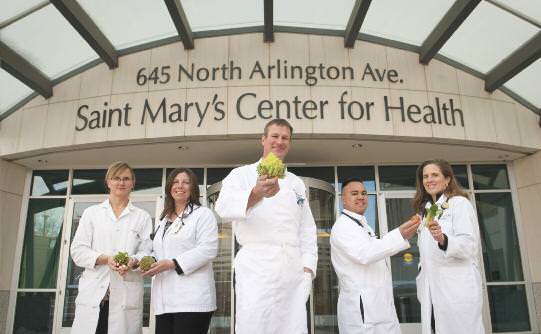WELCOME WELLNESS
Saint Mary’s serves up nutrition.
From left, Dr. Kelly King, Saint Mary’s hospitalist; Tammy Konsonlas, medical services nursing manager; Doug Chapman, director of retail and nutrition services; Dr. Jeffrey Andal, Saint Mary’s hospitalist; and Dr. Karin Klove, physician advisor for Saint Mary’s Breast Center.
WRITTEN BY STEPHANIE STIKA
PHOTO BY CANDICE NYANDO
What comes to mind when you think of hospital food? Do you visualize colorless globs of mashed, tasteless matter sitting next to neon Jell-O? Perhaps it is the hope that if we wind up in the hospital someone will love us enough to bring us food from the outside? Doug Chapman, executive chef at Saint Mary’s Regional Medical Center in Reno for the past 10 years, is on a mission to change that impression.
In Chapman’s kitchen, you won’t find many processed foods. The meals he turns out for Saint Mary’s patients and employees are all made from scratch with a heavy emphasis on low sodium and more healthful options. He also offers vegetarian choices.
“Our goal this year is to reduce protein in meals by 10 percent,” Chapman says, “and replace it with fresh vegetables.”
These aren’t going to be your standard, trucked-in-from-all-over-the-country “fresh” vegetables either. Saint Mary’s and its 42 regional hospitals in three states have buying power.
As Mike Johnson, vice president of community health and mission integration at Saint Mary’s in Reno, puts it, “We have the muscle to influence the types of food purchased.”
LOCALLY SOURCED
Studies have shown that produce begins to lose nutritional value the moment it is harvested. For this reason, Saint Mary’s commitment to health and to the community prompted the hospital to work with U.S. Foodservice to try to buy locally whenever possible and regionally, if it’s not possible. Chapman says this has been a great success.
“U.S. Foods has been very progressive in trying to build a sustainable program and with providing and labeling products that are sourced locally (within the food shed),” Chapman says.
Part of the hospital’s efforts to increase sustainability include not only integrating locally grown foods, but also not accepting dairy products containing growth hormones and trying to eliminate serving any foods including genetically modified organisms. Also, in the hospital bistro, Saint Mary’s offers organic, sustainably grown, and fair-trade coffee by Equal Exchange.
“The coffee is from an equal exchange co-op,” Chapman says. “The money goes directly back to the communities that grow the coffee.”
Chapman would like to see an influx of other local, organic choices as well. But he says the challenge has been trying to find a local producer who can consistently handle the hospital’s volume. For instance, on the day we spoke, he was preparing 750 meals for patients as well as about 1,200 meals for the hospital’s retail outlets.
FOOD BASKET PROGRAM
In a further commitment to a healthy community, Saint Mary’s established a local food basket program for its employees. Partnering with Great Basin Basket CSA, the hospital saw 87 subscriptions last summer, doubling its numbers from 2009. The subscription numbers make Saint Mary’s the largest site for the program.
This season, hospital staff members plan to hold a farmers’ market in conjunction with the basket pickup each week. Johnson attributes the success of the CSA program to marketing.
“Getting in touch with a market (of people) who will consume a basket is the key,” Johnson says. “Health workers tend to be more educated on healthy eating, and are busy people so the convenience is great. They pick up their CSA basket as they leave from work to head home.”
Bringing people closer to their food and farmers is just one more way Saint Mary’s is contributing to the health of our community.
Reno resident Stephanie Stika is a horticulturist and avid gardener. She also has a landscape design and consultation company called Your Plant Guru (Yourplantguru.com).


